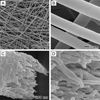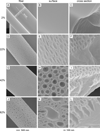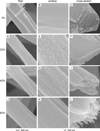Maneuvering the internal porosity and surface morphology of electrospun polystyrene yarns by controlling the solvent and relative humidity
- PMID: 23530752
- PMCID: PMC3681866
- DOI: 10.1021/la400747y
Maneuvering the internal porosity and surface morphology of electrospun polystyrene yarns by controlling the solvent and relative humidity
Abstract
This article presents a simple and reliable method for generating polystyrene (PS) yarns composed of bundles of nanofibrils by using a proper combination of solvent and relative humidity. We elucidated the mechanism responsible for the formation of this new morphology by systematically investigating the molecular interactions among the polymer, solvent(s), and water vapor. We demonstrated that vapor-induced phase separation played a pivotal role in generating the yarns with a unique structure. Furthermore, we discovered that the low vapor pressure of N,N-dimethylformamide (DMF) was critical to the evolution of pores in the interiors. On the contrary, the relatively high vapor pressure of tetrahydrofuran (THF) hindered the formation of interior pores but excelled in creating a rough surface. In all cases, our results clearly indicate that the formation of either internal porosity or surface roughness required the presence of water vapor, a nonsolvent of the polymer, at a proper level of relative humidity. The exact morphology or pore structure was dependent on the speed of evaporation of the solvent(s) (DMF, THF, and their mixtures) as well as the interdiffusion and penetration of the nonsolvent (water) and solvent(s). Our findings can serve as guidelines for the preparation of fibers with desired porosity both internally and externally through electrospinning.
Figures








References
-
- Dawson R, Cooper AI, Adams DJ. Nanoporous organic polymer networks. Prog. Polym. Sci. 2012;37:530–563.
-
- Tsioptsias C, Stefopoulos A, Kokkinomalis I, Papadopoulou L, Panayiotou C. Development of micro- and nano-porous composite materials by processing cellulose with ionic liquids and supercritical CO2. Green Chemistry. 2008;10:965–971.
-
- Yang SY, Ryu I, Kim HY, Kim JK, Jang SK, Russell TP. Nanoporous Membranes with Ultrahigh Selectivity and Flux for the Filtration of Viruses. Adv. Mater. 2006;18:709–712.
-
- Cooper AI. Nanoporous Organics Enter the Cage Age. Angew. Chem. Int. d. 2011;50:996–998. - PubMed
-
- Colombo P. In Praise of Pores. Science. 2008;322:381–383. - PubMed
Publication types
MeSH terms
Substances
Grants and funding
LinkOut - more resources
Full Text Sources
Other Literature Sources

